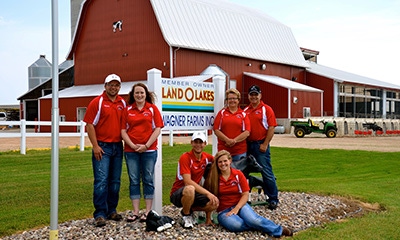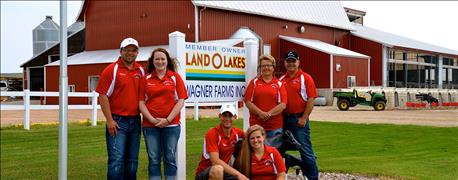
When Hank Wagner was growing up on his family's dairy farm near Oconto Falls, he already knew what he wanted to do when he grew up.
"I was 10 years old and I knew I wanted to be a farmer," Wagner recalls. "I remember way back then reading about the Master Agriculturists in the Wisconsin Agriculturist magazine and I told my dad 'Someday I am going to be a Master Agriculturist.'"
While his friends were involved in sports and activities in school, Hank worked on the farm and loved every minute of it -- and still does, he says.

ALL IN THE FAMILY: The Wagners work together on their dairy farm near Oconto Falls in Shawano County. From left are Shawn and Crystel Wagner, Tyler and Laura Raatz, and Pam and Hank Wagner.
"At the age of 12, I bought two registered Holstein calves to show at the fair," Hank says. "Those calves became the beginning of my dairy herd. My parents paid me a small amount for the milk my few cows produced to help me learn some finance and business lessons early in life."
Along with working on the farm, there was an entrepreneurial spirit in Hank that drove him to do more.
"I cut and sold firewood, built and sold calf hutches and I was repairing and painting farm machinery for neighbors before I was 16," he explains.
He learned how to weld in school and built steel feeder wagons in the farm shed that were sold to area farmers and at local equipment dealerships. After graduating from high school, he worked for two other farmers for two years while he dated a girl who attended the same schools as he did and was a member of the same 4-H club.
"I then got married to my beautiful wife Pam," Hank says.
Hank and Pam combined their 15 cattle and rented a small stanchion barn across the road from his home farm.
"Cows were milked in buckets and we carried all of the milk to the bulk tank," Hank says. "During this time, Pam and I both worked for my parents and traded labor for feed and supplies for our small herd. Our life lessons continued."
After three years, they outgrew that small stanchion barn, so they combined their cattle with his parents herd at the home farm. Two years later, they began the process of buying the farm from his parents starting with the cattle in 1987.
"We had 65 cows. On that day, I became the boss and my dad worked for me," Hank says. "I quickly learned that being the boss was much harder than I imagined and my dad learned that you can't make a living on $3.50 an hour!"
Hank and Pam knew they were going to have to boost profitability. They asked the experts who suggested they build a new facility for 300 cows in the middle of their field.
"Those numbers terrified us, so we decided to grow another way," Hank explains. "Pam's dad was nearing retirement and was only three miles away. So we purchased his 55 cows and rented his land and buildings. After two years of milking in two stanchion barns and young stock in two more, we saw that this was not working. We had gone from one inefficient facility to four and we lost a lot of money in the process which was a blessing in disguise."
They decided to build a 120-cow freestall barn at the home farm and bring all of their cows home. They hired a consultant to help them with the decision. He took their building plans and told them to write short-term and long-term business, family and personal goals. After they were done with that, they had to write a plan to achieve those goals.
"It took months and was stressful, but we eventually built the first freestall barn," Hank says. "That process has become a part of how we do business and life. Having goals and plans to achieve them has the power to bring the future into the present."
Today, the Wagners milk 650 cows and despite a bumpy start 30 years ago, they have achieved one of their first goals of being debt free.
Keeping cows comfortable and fed well has boosted their herd average to more than 31,000 pounds of milk.
Pam and our herdsperson Bev Olson, who has been with us since 1987, do an excellent job of keeping our cows healthy and happy," Hank says. "Our daughter Laura manages the calves and does an awesome job. She has put numerous protocols in place since returning to the farm from college three years ago. Our calf death loss is less than 1/2%."
Young stock move to a custom grower at 6 to 8 months of age and return to the farm two months before calving. Hank and Pam's son Shawn manages the cropping enterprise.
"Shawn has implemented many things to improve yields and the quality of the crops harvested," Hank says. "It's incredibly rewarding to work with my wife and kids and have our grandchild living across the road."
While the Wagners all work hard on the farm, they also make sure they spend quality family time together each week and take time off.
"I watched the sacrifice previous generations made on the farm," Hank says. "Our parents didn't get to take vacations and they had to sacrifice a lot to get the farm to the next generation. One of the main reasons we expanded our farm is so we can have employees and take time off."
Hank credits the six years he served on the Professional Dairy Producers of Wisconsin board of directors, including three years as president from 1998-2000 with helping him learn leadership and to grow as an individual.
"I didn't pursue a position on that board, but I was nominated," he explains. "My name went up there and an hour later I was on the board! I was terrified to speak at first. I learned to be a better listener and a better speaker. And I learned growing yourself will take you places you never dreamed of going. I will forever be indebted to PDPW for that."
His experiences with PDPW inspired Hank to start a business called Wagner Leadership Training so he can bring the rewards he experienced to so many others.
About the Author(s)
You May Also Like






